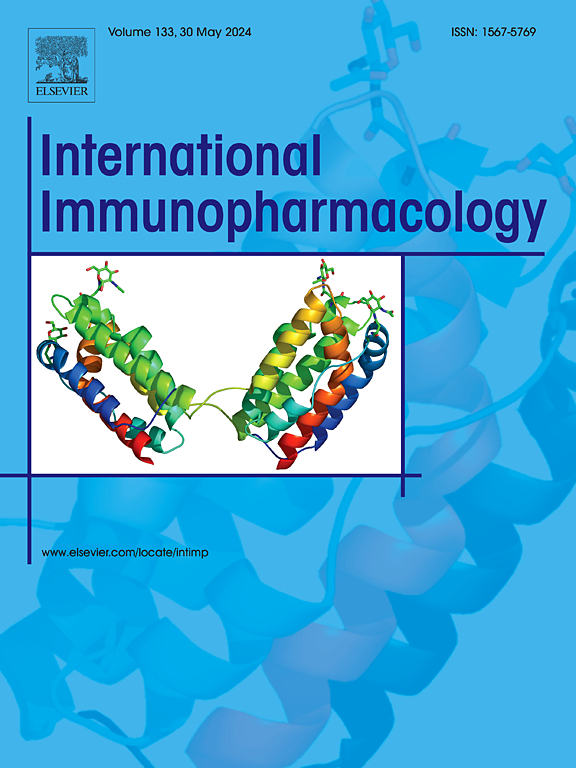Inhibition of phosphodiesterase-4 by rolipram alleviates anxiety-like behavior in mice with PTSD by modulating neuroinflammation and synaptic plasticity via cAMP signaling
IF 4.8
2区 医学
Q2 IMMUNOLOGY
引用次数: 0
Abstract
Background
Post-traumatic stress disorder (PTSD) is a mental disorder in which individuals exhibit fear and anxiety due to recurrent painful memories. Rolipram, a PDE4 inhibitor, exerts neuroprotective effects via anti-neuroinflammation, yet the role of PDE4 in PTSD pathogenesis remains unclear. This was addressed by exploring the molecular mechanisms through which rolipram exerts its therapeutic effects in PTSD.
Methods
The PTSD mouse model was established by a combined protocol of single prolonged stress and footshock (SPS&FS). The activity of PDE4 in the brain was measured using high-performance liquid chromatography (HPLC). The behavioral effects of rolipram (1 mg/kg/d for 14 d) on the PTSD model were assessed by behavioral tests. Additionally, the impact of rolipram on neuroinflammation and synaptic deficits was evaluated in these mice using a combination of biochemical assays and morphological analyses.
Results
The PTSD mice showed abnormal behavioral changes, increased PDE4 activity, elevated levels of inflammation, and synaptic deficits. Administration of rolipram (1 mg/kg/d, i.p.) restored cAMP/PKA signaling, reduced the release of pro-inflammatory cytokines (IL-6 and IL-1β) and inhibited microglial activation in PTSD mice. Additionally, rolipram ameliorated PTSD-like behaviors and synaptic defects. The neuroprotective and anti-inflammatory effects of rolipram were abolished by co-treatment with the PKA inhibitor H89.
Conclusion
In summary, we demonstrated that rolipram ameliorated PTSD-like behavioral abnormalities, neuroinflammatory responses, and hippocampal synaptic deficits by activating the cAMP-PKA signaling pathway. These results suggest that PDE4 inhibition may serve as a promising therapeutic strategy for PTSD.
罗利普兰抑制磷酸二酯酶-4通过cAMP信号调节神经炎症和突触可塑性,减轻PTSD小鼠的焦虑样行为
创伤后应激障碍(PTSD)是一种精神障碍,患者由于反复出现的痛苦记忆而表现出恐惧和焦虑。罗利普兰是一种PDE4抑制剂,通过抗神经炎症发挥神经保护作用,但PDE4在PTSD发病机制中的作用尚不清楚。通过探索罗利普兰在PTSD中发挥其治疗作用的分子机制,解决了这一问题。方法采用单次长时间应激和足部冲击联合方案建立创伤后应激障碍小鼠模型。采用高效液相色谱法测定脑内PDE4活性。采用行为学测试评价罗利普兰(1 mg/kg/d,连用14 d)对PTSD模型的行为影响。此外,在这些小鼠中,使用生化分析和形态学分析相结合的方法评估了罗利普兰对神经炎症和突触缺陷的影响。结果创伤后应激障碍小鼠表现出异常行为改变、PDE4活性升高、炎症水平升高和突触缺陷。罗利普兰(1mg /kg/d, ig)可恢复创伤后应激障碍小鼠cAMP/PKA信号,减少促炎细胞因子(IL-6和IL-1β)的释放,抑制小胶质细胞的激活。此外,罗利普兰改善ptsd样行为和突触缺陷。罗利普兰与PKA抑制剂H89联合治疗后,其神经保护和抗炎作用消失。综上所述,我们证明了罗利普兰通过激活cAMP-PKA信号通路改善了ptsd样行为异常、神经炎症反应和海马突触缺陷。这些结果表明PDE4抑制可能是一种有希望的治疗PTSD的策略。
本文章由计算机程序翻译,如有差异,请以英文原文为准。
求助全文
约1分钟内获得全文
求助全文
来源期刊
CiteScore
8.40
自引率
3.60%
发文量
935
审稿时长
53 days
期刊介绍:
International Immunopharmacology is the primary vehicle for the publication of original research papers pertinent to the overlapping areas of immunology, pharmacology, cytokine biology, immunotherapy, immunopathology and immunotoxicology. Review articles that encompass these subjects are also welcome.
The subject material appropriate for submission includes:
• Clinical studies employing immunotherapy of any type including the use of: bacterial and chemical agents; thymic hormones, interferon, lymphokines, etc., in transplantation and diseases such as cancer, immunodeficiency, chronic infection and allergic, inflammatory or autoimmune disorders.
• Studies on the mechanisms of action of these agents for specific parameters of immune competence as well as the overall clinical state.
• Pre-clinical animal studies and in vitro studies on mechanisms of action with immunopotentiators, immunomodulators, immunoadjuvants and other pharmacological agents active on cells participating in immune or allergic responses.
• Pharmacological compounds, microbial products and toxicological agents that affect the lymphoid system, and their mechanisms of action.
• Agents that activate genes or modify transcription and translation within the immune response.
• Substances activated, generated, or released through immunologic or related pathways that are pharmacologically active.
• Production, function and regulation of cytokines and their receptors.
• Classical pharmacological studies on the effects of chemokines and bioactive factors released during immunological reactions.

 求助内容:
求助内容: 应助结果提醒方式:
应助结果提醒方式:


